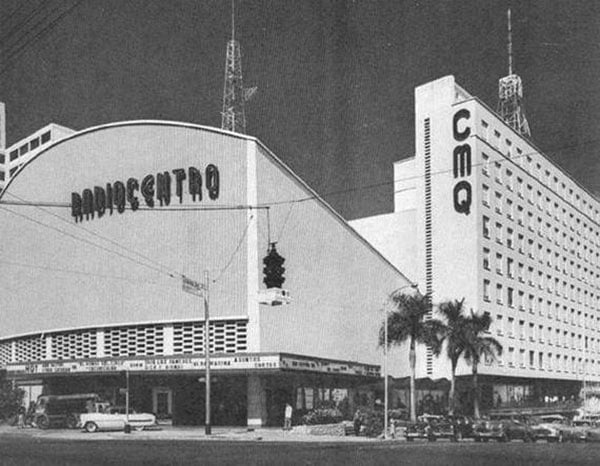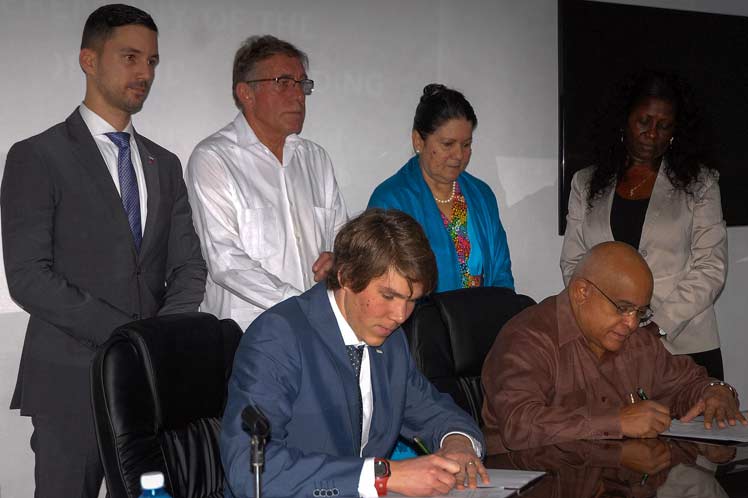Last March 3 marked the beginning in 1946 (77 years ago) of the construction of an emblematic building for Cuban radio and later for television. Not in vain it was called Radio Centro, since it was located on 23rd Street between L and M Streets, and had such an imprint that it brought forth a new and transcendental neighborhood running towards the Malecón, called La Rampa.
From then on, this new neighborhood was identified by tall buildings and the largest circulating population of all Cuba, especially one of recreational interest; this, in addition to all the contributions that with the passing of time it would bequeath to Cuban and international culture.
The building was conceived in the style of Radio City (1932) in Manhattan, New York, as a complex for movie theater, radio studios and, almost immediately, for television as well, with a gallery of shops and a theater, market facilities, offices… It was a ten-floor building featuring three elevators.
Its intellectual architect was the wealthy media magnate from Santiago de Cuba (1912-1993, later nationalized Argentinian), Goar Mestre Espinosa. His intention consisted in bringing together in one facility, the so many and dispersed radio stations that existed. The building would turn into their core of operations located in a city area increasingly more central. Its location was even more decisive in its thriving as it received support from various American firms such as RCA Víctor and Warner Brothers. The building was equipped with the most modern and expensive recording equipment available. It was officially inaugurated on March 12, 1948, as the headquarters of Circuito CMQ S.A., and was blessed by Manuel Arteaga, Cardinal Archbishop of Havana.
It was the first building in Havana with centralized air conditioning and has been the headquarters, since its foundation in 1965, of the Cuban Institute of Radio and Television (ICRT), and host to the popular movie theater, born as Warner, that soon was named after the building, Radio Centro . However, as of 1968 it was called Yara to honor the Ten-Years War on its centenary.
Featuring a rationalist and functionalist style and awaking architectural interest (the first of modern architecture, and of multifunctional purpose), this building of artistic, cultural and historical worth was born to the enthusiastic and skilled work of Miguel Gastón and Emilio del Junco Ramírez, and to the mastery of the Basque architect Martín Domínguez Esteban (San Sebastián, 1897-New York, 1970), who showed his ties to the European avant-garde. He had gone into exile from the Spanish Civil War and settled in Havana at the beginning of January 1937, where he married a Havana maiden with whom he had a son, who followed his father’s steps.
Domínguez, not having validated his degree as an architect, had to work in collaboration with other architects, in this case with Gastón y del Junco, with whom he left other works in our country, and with other architects, before leaving Cuba in 1960. Gastón, Junco and Domínguez were members of the Cuban section (ATEC) of the International Congresses of Modern Architecture(CIAM), (1928-1959). To construct their building, given its multifunctional purpose and in compliance with the Vedado regulations, they required a permit.
As of 1931, buildings with more than three floors were banned, however, given the need for taller buildings, as shown by many designers and businessmen, the prohibitive ruling was modified in 1937 to allow a fourth floor. Radio Centro was set five meters back from the alignment, to later add another four meters of portico, which kept the construction distanced from the avenue, while adjusting to 23rd Street’s steep slope .
The portico thus turned into a wide gallery, which divided the plinth of the body of offices; a gallery that became the covered lobby of the movie theater on the upper corner of L Street, which had an expressionist body with a high curved roof, ascent that was adjusted in the restaurant located on the opposite corner on M Street; a wide access gallery to the lobby of the office building. The third building is made up by a prismatic piece on M street, also set back, to make emphasis on both corners.
This building had such an impact that an article about it was published in the magazine L’Architecture’aujourd’hui, and was predecessor for many of the following buildings, such as the Habana Hilton hotel, later called the Tryp Habana Libre. Through this work, Domínguez made contact with Ernesto Gómez Sampera, with whom he shared expertise in the construction of the Focsa building, one of the seven wonders of Cuban engineering, and of the building hosting the Ministry of Communications.
On occasion of his visit to Havana in 1949, the eminent German architect, urban planner and designer, founder of the Bauhaus School (1919) referred to this building as a model, and championed the need for teamwork with various specialists, and coordinated by an architect.
The movie theater, inaugurated on December 23, 1947, had a capacity for 1,700 spectators; short shows were presented on its stage to entertain the audience during the intermissions of the films. The CMQ radio circuit occupied part of the offices in the building, attached to the block of offices for rental. In this area, a part of the terrain had been reserved for future television installations, and one of its studios, No. 2, was the venue to radio program transmissions and also to all, or at least most, of the musical recordings of the RCA Víctor record label in Cuba, during the 1948 – 1959 period. The ground floor was common to the entire complex, with different shops, various exhibition halls, a bank, a restaurant and a cafeteria; pedestrian circulation was designed to pass in front of these premises.
Under the Chinese restaurant El Mandarín, several business facilities have operated, including a pharmacy, a variety items and photography shops , among the many functions of this construction.
This building, featuring great attraction, has been host to the creation of an essential part of genuine works of art, especially of the media, in its widest spectrum. For this reason, its connection has been essential with other artistic fields, such as music, theater, literature and visual arts, always maintaining close ties with emblematic personalities of Cuban culture. All this has served as solid foundation to its patrimonial worth in the eyes of all humanity.
Bachelor María Salomé Campanioni → Journalist and General Editor of the Cuban Radio Portal Twitter: @radionline Translation by Gilda Gil



